Etsy Product Line Critique & Coaching Plan (GI Ceramics)
Tania owns a business called Geometric Illusion Ceramics. She reached out to me after reading my article: How to Develop a Product Line Using the 3 – 5 Strategy
She knew she needed to reign in her product line but didn’t know how to get started.

Tania agreed to let me use her Etsy shop and product line as an example to help explain how a business with too much product variety can start to refine.
If I were coaching Tania one-on-one, these are the first few steps I would recommend she take.
Step 1 – Target Market
Tania has read my article on finding a target market but is having difficulty relating the advice to her business and products.
“My ‘style’ seems to fit nowhere. The reason I battle with the collection as a whole is I don’t know where it belongs under any category or person.”
I believe a lot of people get stuck in this way of thinking; they’re trying to take their existing products and fit them into an existing target market.
The key is to start with a target market’s interest/lifestyle/style/etc. and then adapt your products.
You can see from Tania’s current product line that she’s very versatile with the styles she can appeal to. So it will be easy for her to choose a target market and adjust her style to appeal to them.
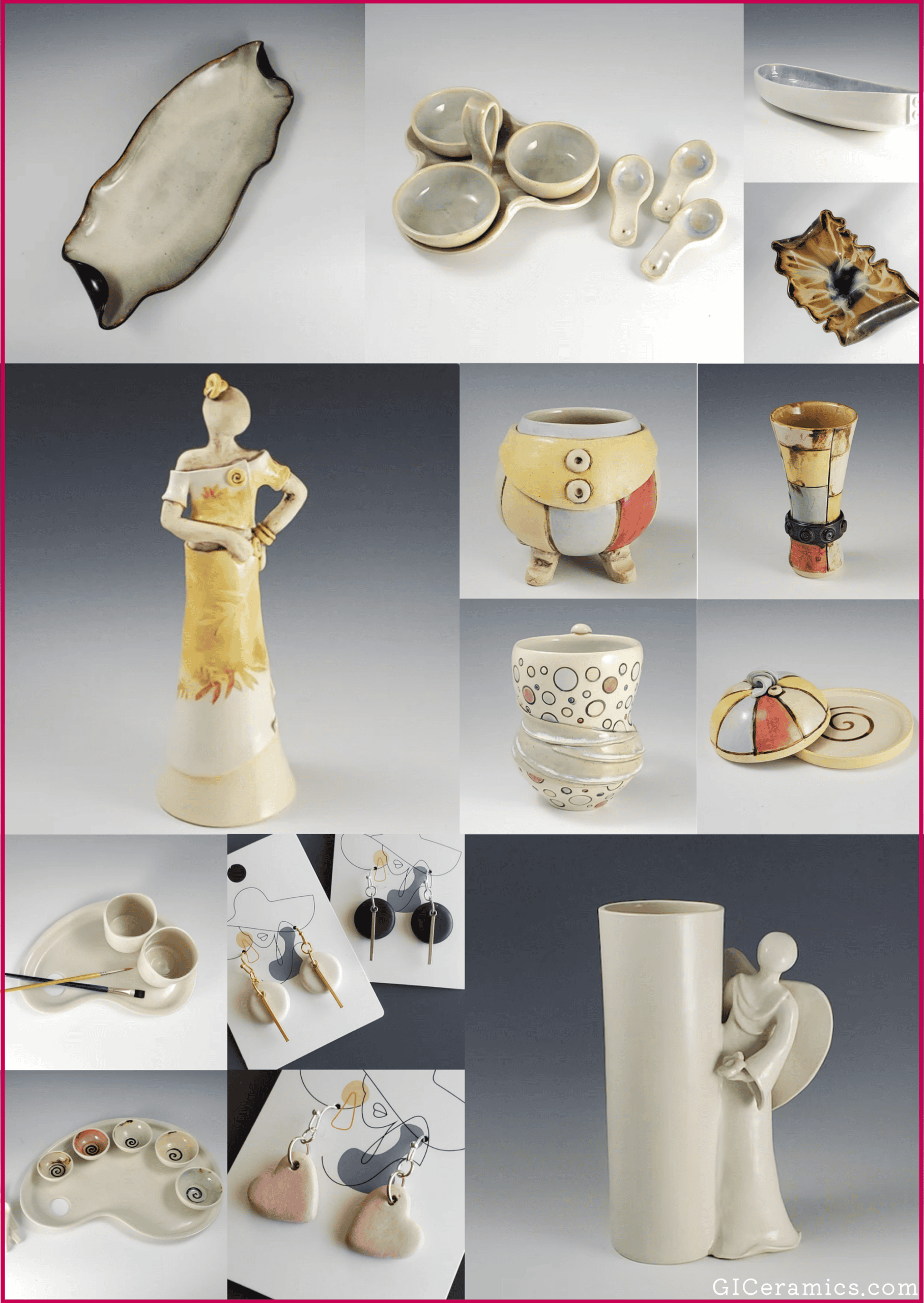
When choosing a target market, you have to consider the product feature people care about most.
The majority of Tania’s products are dinnerware (e.g. serving trays, bowls, condiment caddies, etc.) or home decor pieces (e.g. vases, sculptures, decorative boxes, etc.).
When people are buying items like these, they first and foremost want the piece to fit their decor style.
So it makes sense to choose a target market based on a popular style of home decor/decorating.
Question for Tania to answer: What style of decor does your ideal customer have?
Again, it’s important to think about a target market first and then adapt her pieces to that market.
If she starts with her pieces and then describes her ideal customer’s decor style, she may end up describing a style that doesn’t really exist or is hard to find.
Existing target markets based on decor style might be:
- Modern Farmhouse
- Boho chic
- Modern
- Scandinavian
- French Country
- Nautical
- Etc.
If we use Tania’s current products to nudge her in a direction, I see a few themes:
Coastal Decor Style
The most obvious decor style I see among her current products is coastal.
The 4 pieces at the top of the image below are Tania’s. You can see how well they would fit into a coastal-style living room when serving guests snacks.
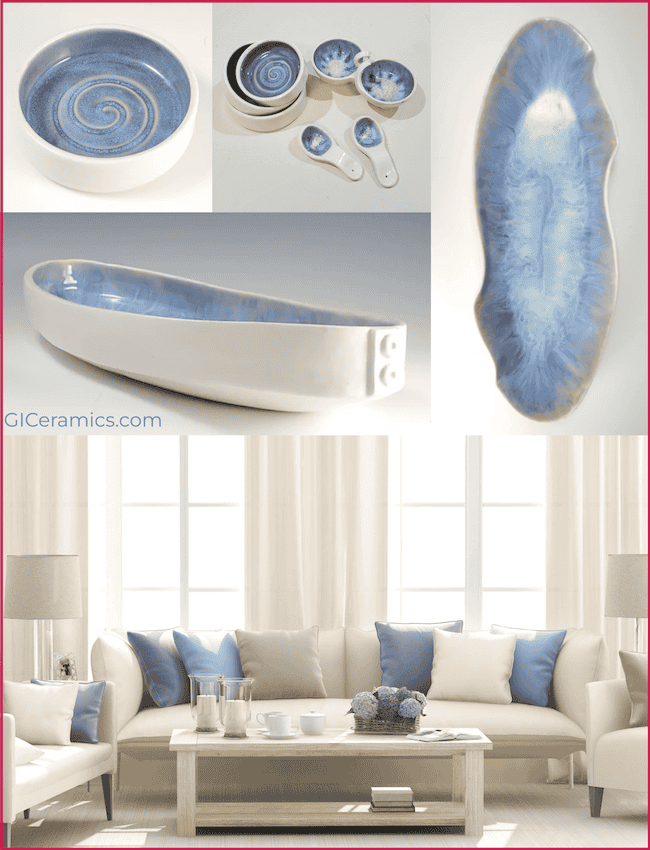
There are also a few other directions Tania could go in with her target market by appealing to an interest/psychographic other than decor style:
Artists/Crafters
Tania currently offers a few pieces for artists.
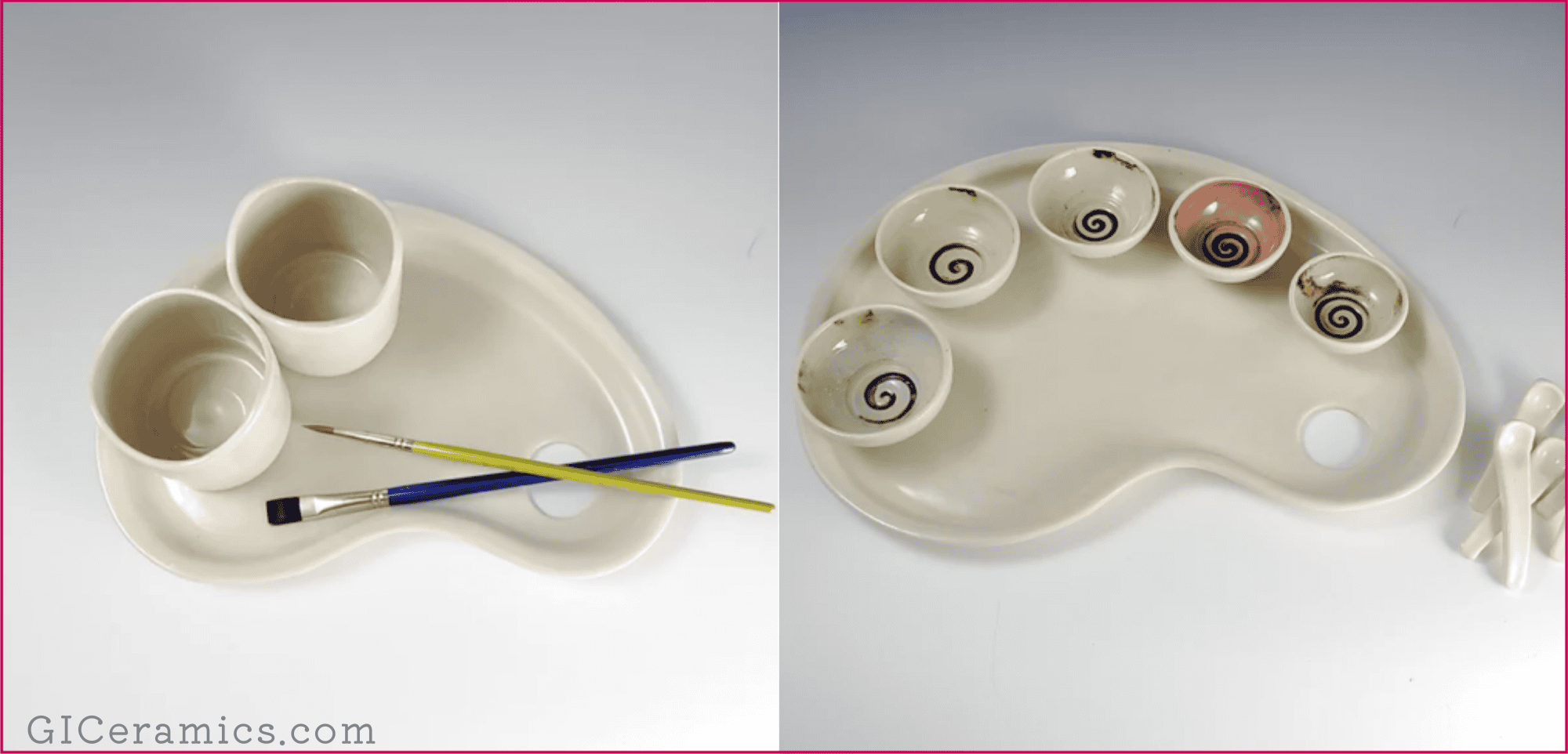
If this were a market she was interested in targeting, she could expand into ceramic items such as:
- Different styles of palettes and mixing bowls for paints
- Containers to hold paintbrushes
- Yarn bowls
- Etc.
This would create opportunities for Tania to market her products to:
- Arts and craft stores to buy her products wholesale
- Art/craft magazines and blogs
- Sell at art-related events
- Etc.
Fishing
Tania currently offers a few fishing-themed products. She could focus her ceramics on appealing to a fishing target market by incorporating fish images and designs into all of her pieces.
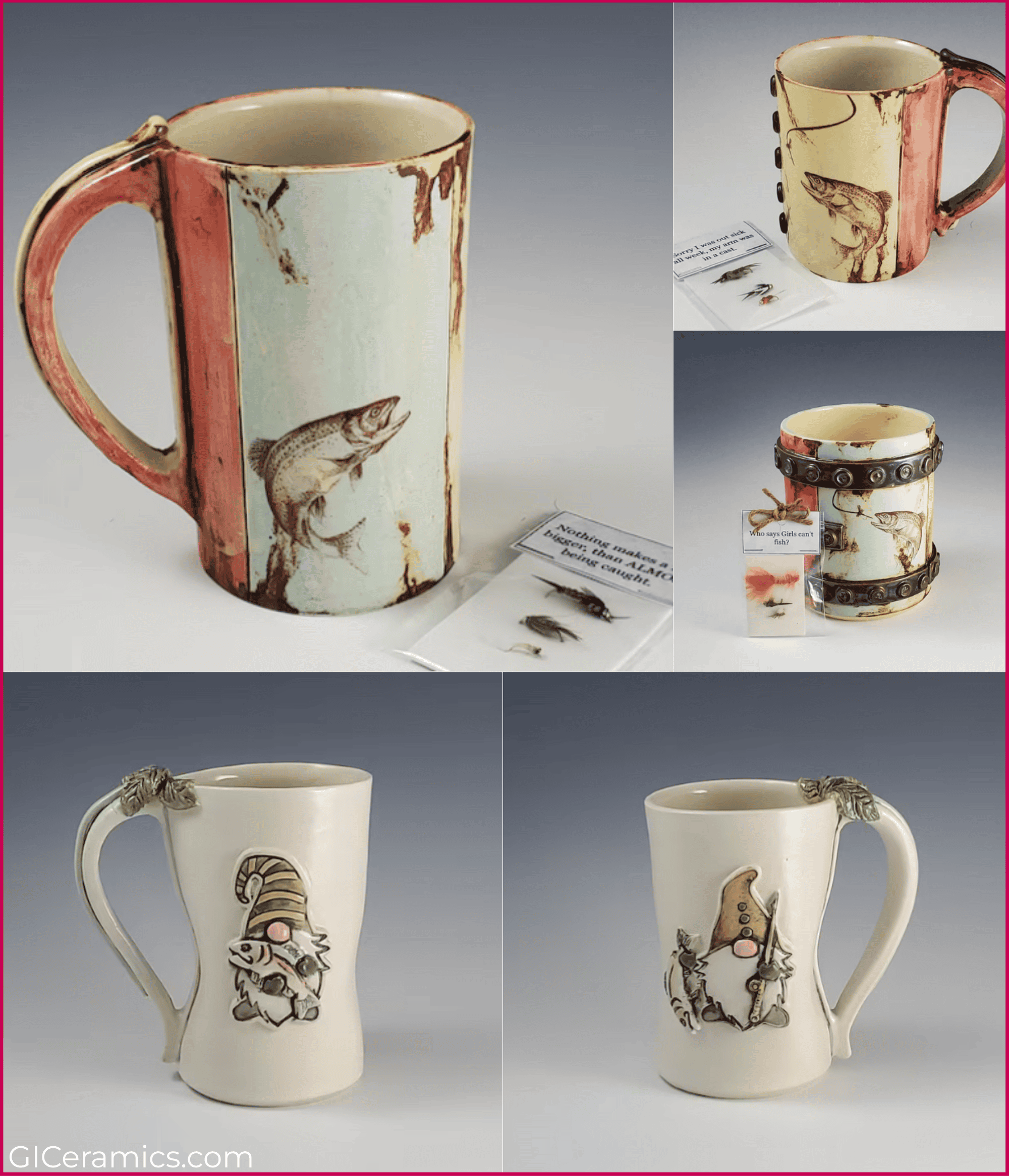
For example:
- Decorative trays and serving dishes in the shape of fish
- Fish designs stamped into mugs and serving dishes
- Apply the painted fish to creamer pitchers and sugar bowls to create a set, etc.
This may be a bit harder to find her target market as people who read fishing blogs aren’t necessarily looking for ceramic dishes. And when people who visit fishing stores for fishing supplies, they typically aren’t also in the market for dinner and drinkware.
However, there could be an opportunity to market her fish-themed ceramics as gifts for fishermen.
Tania lives in Colorado and mentioned her fishing mugs are often purchased at craft shows, as gifts. If there were enough local craft shows throughout the year, fishing-themed mug sets and other dinnerware pieces may be a good direction.
She could also research local gift shops to see if fishing-themed pieces would work in them.
Online, there is a high search volume for “gifts for fisherman”. There are also resources such as forum threads and blogs (e.g. “10 best gift ideas for Anglers”) that provide opportunities for a fishing-themed set of mugs, bowls, etc. to be featured.
Other products
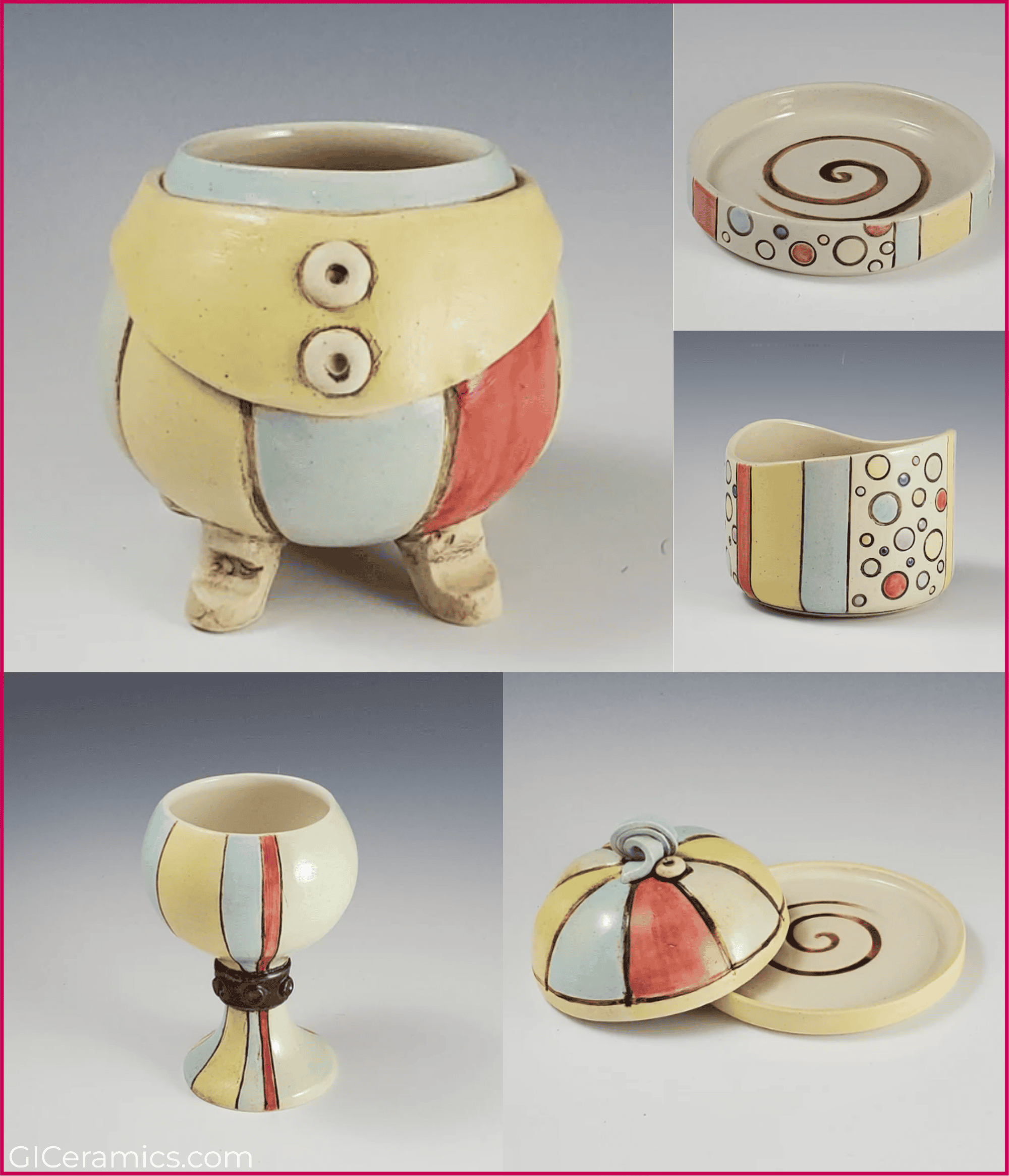
Tania also has a decent selection of pieces she describes as “whimsical”.
These are a little harder to work with when it comes to a target market because they don’t appeal to a common interest or clearly fit into an existing decor style box (e.g. coastal, modern farmhouse, etc.).
Some might describe the pieces as whimsical or playful while others might describe them as eclectic. So it makes it harder to match the style to an existing target market.
That’s not to say they’re not a fit for people’s home decor styles. It just makes it harder for her to find her ideal customers and would require a marketing strategy that focuses on her ideal customers coming to her.
Craft shows
Selling at events each month would be a good way for Tania to have shoppers coming to her.
SEO (search engine optimization)
Another way to ensure shoppers are coming to her would be to focus on keyword research and creating products based on highly searched ceramics.
For example, thousands of people search “ceramic vase” and “ceramic pots/planters” each month (and Etsy captures a portion of that traffic). Someone searching “ceramic vase” hasn’t narrowed down the exact style they want. So a portion of those shoppers may be interested in a whimsical style of ceramic vase.
If Tania filled her Etsy shop with ceramic vases, ceramic pots, and other items with high search terms, she has a chance to attract enough shoppers to her online store to be able to focus on her whimsical style.
On the other hand, “ceramic candy dish”, “ceramic cheese dome”, and “ceramic condiment caddy”, have very low search volumes and wouldn’t attract many people to her shop. She could still offer them, but she would need the higher-volume keywords/products to attract the majority of her traffic.
Tania’s homework
Decide on a target market based on:
1) Marketing strategy
If Tania wants to have an easier time reaching her target market, it would be important to work with an existing target market based on popular home decor styles (e.g. coastal) or a common interest (e.g. fishing). If Tania didn’t want to create pieces that fit into an existing decor/dinnerware style (e.g. she wanted to focus on her whimsical style), she would need to develop a marketing strategy that focuses heavily on SEO and craft shows to ensure enough shoppers come to her.
2) How easily can you reach your target market
Let’s say Tania was thinking about focusing on fishermen/anglers as a target market. She would need to consider how easily it would be to reach fishermen/women.
Does she live in a city with lots of fishermen/women? Are there many local shops that target fishermen/women? Can she find blogs/magazines/sections in the local newspaper that focus on the topic of fishing and might feature her products?
If the answers to those questions are yes, it may be a good target market to focus on. If the answers are no, Tania would want to explore other target markets that offer better marketing and selling opportunities.
3) Tania’s personal preference
It’s important to understand your target market so you can easily connect with them. If Tania loves the coastal decor style and decorates her home that way, she’ll intuitively know what her target market wants. But if that’s not really her vibe, it may not be the best direction to go in.
Step 2 – Purpose
The next step Tania can take to refine her product line is to determine the purpose her products will serve in her target market’s lives.
Currently, Tania sells pieces that help shoppers:
- Decorate their home (vases, pots for home, angel statues, decorative boxes, etc.)
- Serve food & drinks (serving trays, mugs, condiment caddies, etc.)
- Paint (artist palettes)
- Accessories (earrings)
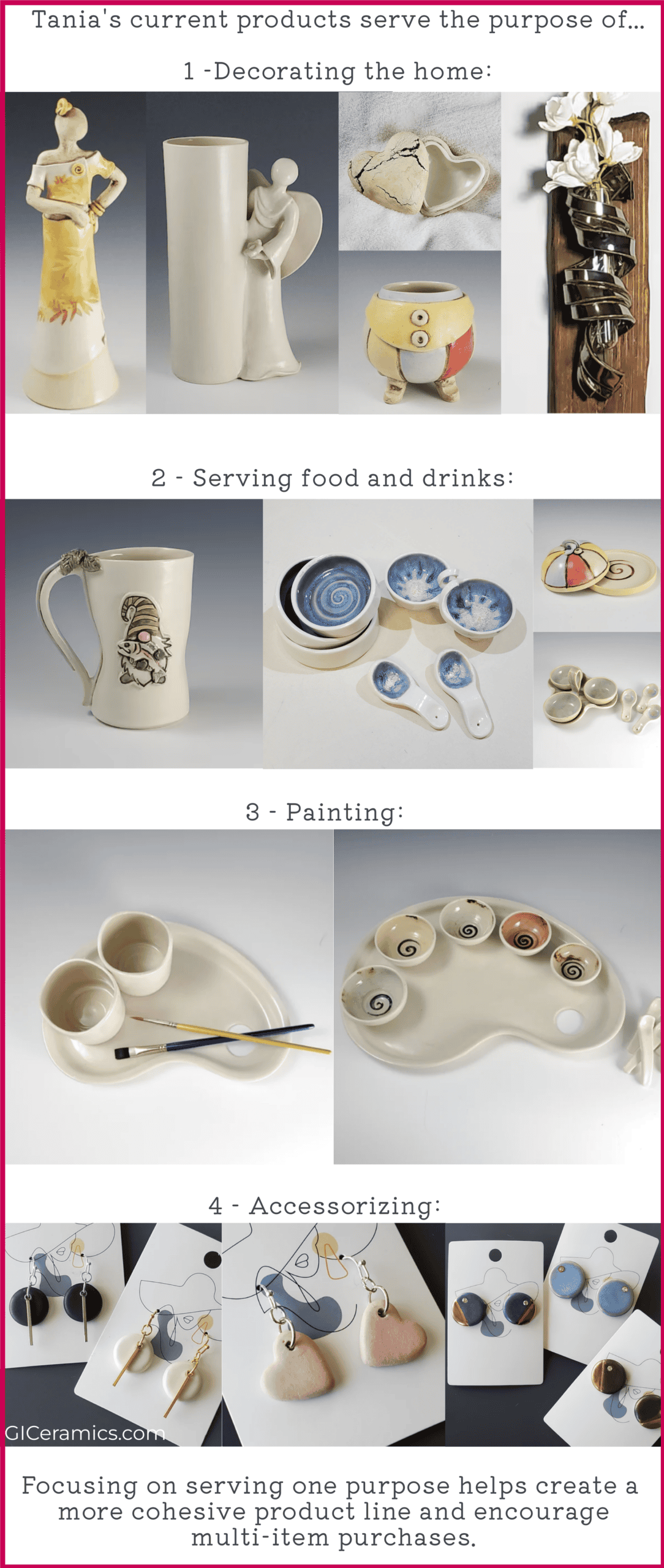
Although there are lots of products for shoppers to choose from, the wide variety makes it difficult for one customer to buy multiple items.
If I’m an artist who has found her beautiful artist palettes, I may also want matching ceramic containers to hold my brushes, clean my brushes, and perhaps a rest for my paintbrush. But I only have one item to purchase from her shop.
Question for Tania to answer: With your target market in mind, what’s the one goal you want to help them achieve with your products?
For example, that goal/purpose might be to use beautiful ceramics when:
- Serving food (gravy boat, condiment dishes, serving trays, etc.)
- Decorating shelves and walls (with vases, pots, and figurines)
- Cooking in the kitchen (with oil & vinegar dispensers, salt cellars, spoon rests, etc.)
- Creating art/crafts (with artist palettes, paintbrush containers, yarn bowls, etc.).
Tania would focus on one of those purposes to start.
You can get as specific/niche as you like with the goal/purpose.
Creating a full line of serving dishes may be too many items to stock. So Tania could niche down and focus on dishes for serving tea and coffee.
When deciding how much product variety to offer, my general rule is to be able to do one thing really well before expanding.
For example, if Tania were starting with the purpose of serving tea and coffee, she would want to be able to create a full set of tea/coffee ceramics before expanding into a different purpose.
Imagine seeing an Etsy shop full of matching:
- Coffee mug sets
- Latte mug sets
- Coffee drippers
- Teacup and saucer sets
- Teapots
- Creamer pitchers
- Sugar bowls
- Honey pots
- Coasters
- Etc.
You immediately think of a beautiful morning coffee/tea ritual or serving coffee/tea to friends and family. And shoppers will want the full set; not just the coffee mug.
But if Tania were to only make a few coffee mugs and then move into serving a different purpose, such as decorating with sculptures and vases, the coffee mugs wouldn’t paint the full picture on their own. Not to mention, the shopper who falls in love with her coffee mug doesn’t have another piece to buy with it.
A coffee mug and creamer pitcher are items consumers buy and use together; a coffee mug and vase are not.
If and when Tania is ready to expand into a new purpose, it would be important to ensure there is still a connection between all of her products. If she started with the focus of serving dishes and then added decorative pieces (e.g. vases, decorative bowls, etc.), those decorative pieces should work with her serving dishes. So someone buying a coastal-style condiment set can also buy a coastal-style vase or decorative bowl that matches.
Tania’s homework:
Decide on one main purpose you want your products to serve in your customers’ lives.
Go as niche as you need to so you don’t feel overwhelmed and can create a small collection of products to test.
This collection should be products customers could buy as a set; everything should work together.
You don’t need to get rid of every piece that doesn’t fit within that purpose, but pieces that serve that purpose should be at the forefront (i.e. top of your Etsy shop or getting the most space on your craft show table). And any new pieces created should also fit within that main purpose.
Step 3 – Signature style
A signature style will also help create cohesion among your products so almost every piece works together and can be loved and owned by the same customer.
The key to creating a signature style is to have one visual element consistent in every product.
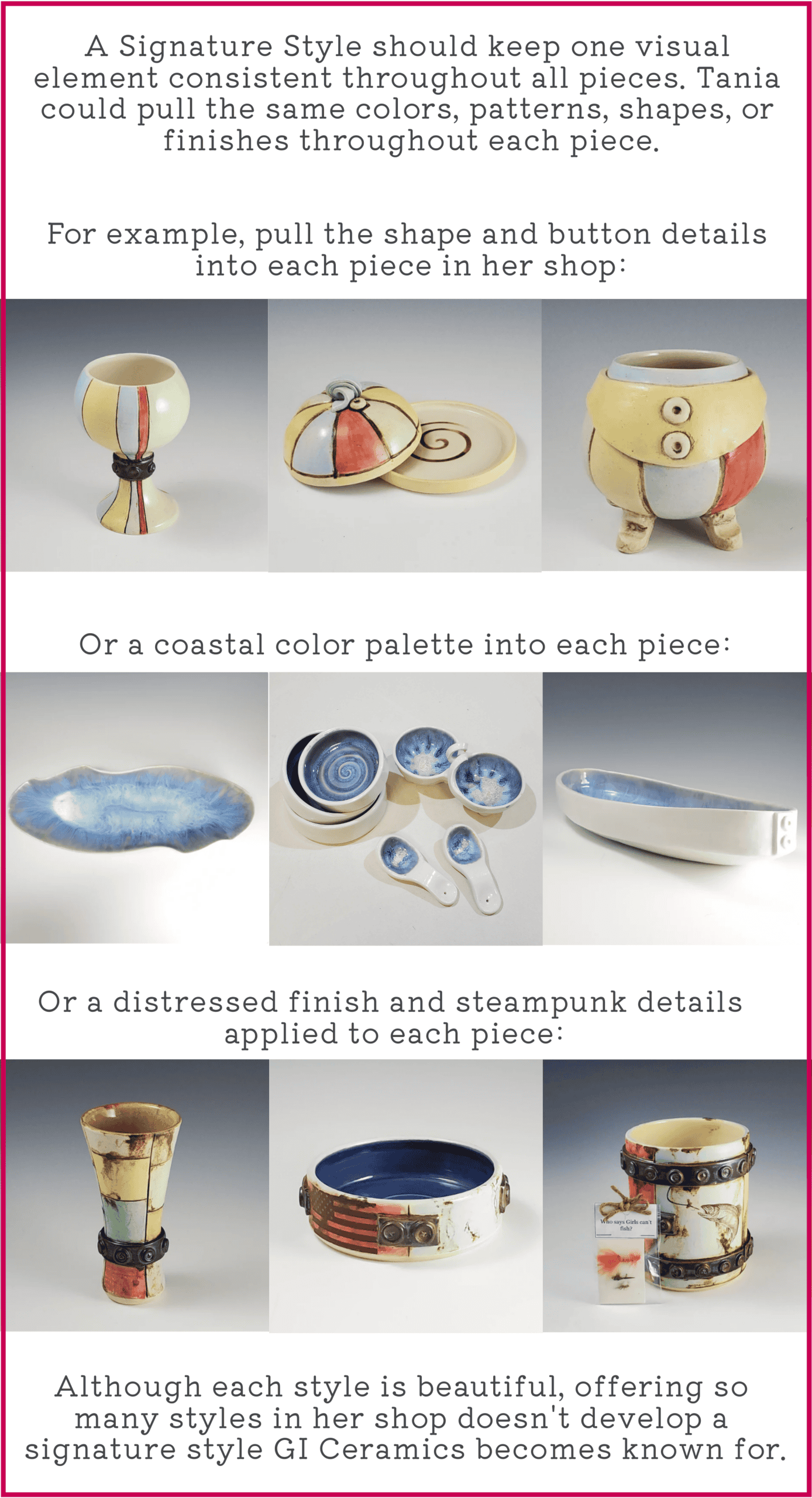
For example:
- A color palette (e.g. every item in Tania’s shop might be blue, seafoam green, or sandy/driftwood brown)
- Style (e.g. every piece might follow a clean and modern style)
- Shape (e.g. every piece has a rounded shape)
- Finish (e.g. every piece might have a matte finish)
- Detail (e.g. every item has a fish on it)
- Etc.
The more visual elements that are kept consistent, the stronger and more identifiable the signature style.
For example, if every piece Tania makes is blue, green, or taupe, AND has a modern style, AND has a “water-like” glaze finish, that develops a unique style that her customers will come to her for.
This not only makes a strong visual statement in a craft show display or online shop, but it also ensures long-time customers can come back again and again to add to their collection.
When there’s too much variation from one style to the next, customers can’t mix and match to create sets. And when they’re ready to buy again, months or years down the road, it’s unlikely they’ll find an item to match an older piece they already own.
You can offer more variation through collections.
Let’s say Tania decided to keep a coastal color palette consistent in all her pieces. She may create collections based on different shapes:
- Collection 1: boat-shaped pieces
- Collection 2: shell-shaped pieces (with wavy, organic edges)
- Collection 3: geometric-shaped pieces (e.g. circular)
Tania’s homework
Define one or more visual element(s) you will keep consistent from one product to the next.
Keep your target market in mind, but this is where your individual style can shine through.
For example, if Tania is targeting people with a coastal home decor style, her pieces should fit within the coastal-style box, but she could put her spin on it.
Final Product Line Example
Let’s take the steps above and look at how Tania may combine them to refine her product selection.
Step 1 – Target Market: Coastal Decor Style
Step 2 – Purpose: Serving Dishes
Step 3 – Signature Style: Coastal color palette and “water” glaze
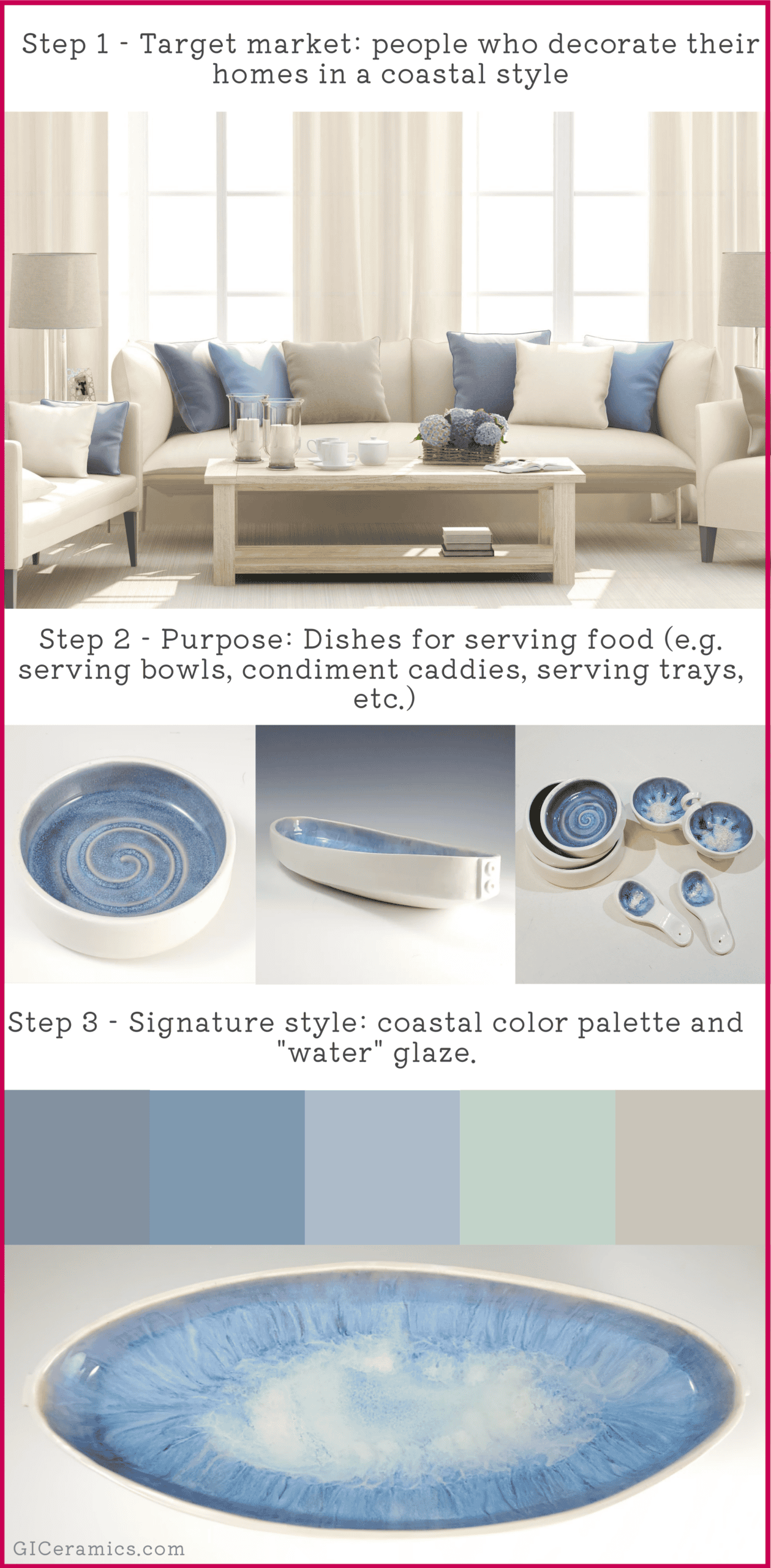
Start slowly
One of Tania’s hesitations about narrowing down her product line was losing customers/people to sell to. It’s a valid fear and one we all deal with.
I only bought into the idea of less is more when I had sales to prove it. However, I transitioned to fewer products and styles slowly.
You can A/B test your products to decide which direction to go in, or for confirmation that you’re going in the right direction.
Let’s say Tania wanted to test her two main styles: coastal and whimsical, and use the pieces she currently has to get a clue as to which target market, purpose, and style she should focus on.
At a craft show, she could display all coastal pieces on one side of the table and all whimsical pieces on the other side.
Within those two groupings, she could create smaller groupings:
- Group all vases and decorative pieces together
- Group all serving dishes together
- Etc.
Then pay close attention to shopper behaviour, sales, and other stats (if possible).
For example:
- Which side of the table tends to grab more shoppers’ attention?
- Which side of the table do shoppers spend more time at?
- Does one side of the table get less attention than the other? (e.g. maybe shoppers ignore the coastal-style pieces altogether)
- How many shoppers were at the event? (the organizer should have this number)
- How many shoppers stopped at her table?
- How many shoppers purchased a whimsical piece?
- How many shoppers purchased a coastal piece?
Sales should be tracked accurately so you know exactly which pieces are sold at each event.
However, the number of shoppers can be a little harder to track, so it’s okay to work with rough numbers.
I would keep a sheet of paper and after a group of shoppers leave the table, simply put a tick for each shopper.
Depending on how busy the event is, you may be able to track more numbers. Such as how many people looked at one style versus another.
The more numbers you track the better you’ll be able to calculate conversion rates so you know which type of product and style of product converts more shoppers into customers (our ultimate goal).
Sometimes a product can seem popular because many people look at it, but we want the conversion rate of a product to be high (the percentage of people a product converts from a shopper into a customer).
For example, let’s say 50 people spend time in the “whimsical section” and one person buys, while 10 people spend time in the “coastal section” and one person buys.
Without tracking numbers, the whimsical pieces would seem more popular. However, the whimsical pieces have a 2% conversion rate while the coastal pieces have a 10% conversion rate.
In this scenario, I would give more space to the coastal pieces at the next craft show, and use sales and stats to confirm that’s the right direction to go in.
It’s a constant cycle of test then tweak, test then tweak.
You can check out Tania’s Etsy Shop here: https://www.etsy.com/shop/GiCeramics and her website here: https://giceramics.com

Hey, I’m Erin 🙂 I write about small business and craft show techniques I’ve learned from being a small business owner for almost 2 decades, selling at dozens of craft shows, and earning a diploma in Visual Communication Design. I hope you find my advice helpful!

This was really helpful! Thank you and thanks to Tania for offering up her shop for critique!
Jennifer, I am honored Erin was prepared to share so much of her time & knowledge to this. It is the clearest it has ever been to me to & makes total sense.
Tania
Thanks so much for this and thanks to Tania for allowing us to learn from her lovely shop.
Thanks Kim, you’re too kind. There is definitely LOTS to learn from the Article for sure.
This is really helpful information. It gives me a lot to think about. Big thanks to Erin and Tania!
Absolutely excellent- very practical- Tania is very gifted- sometimes talented artisans can have too many ideas and Erin was so clear and helpful- I will be interested to see how Tania develops- hope we get a follow up.
Would love to see Erin do this with a jewelry Etsy site-I have put popular pieces I sell in person on my Etsy site-cannot figure out my target market.
Hit and miss. Lvandenbergjewelry.etsy.com
Thank you, Lynn for the compliment, I keep running through my head ‘Because you can, doesn’t mean you should’
I’m going to keep in touch with Erin with feedback for sure, definitely a process.
This article is soooo helpful! It has helped me as have countless other readings from Erin. I love the ‘test then tweak” strategy. Thank you, both!!